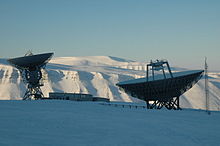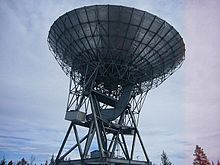EISCAT


EISCAT (European Incoherent Scatter Scientific Association) operates three incoherent scatter radar systems, at 224 MHz, 931 MHz in Northern Scandinavia and one at 500 MHz on Svalbard, used to study the interaction between the Sun and the Earth as revealed by disturbances in the ionosphere and magnetosphere. At the Ramfjordmoen facility (near Tromsø, Norway), it also operates an ionospheric heater facility, similar to HAARP. Additional receiver stations are located in Sodankylä, Finland, and Kiruna, Sweden. The EISCAT Svalbard radar (ESR) is located in Longyearbyen, Norway. The EISCAT Headquarters are also located in Kiruna.
EISCAT is funded and operated by research institutes and research councils of Norway, Sweden, Finland, Japan, China, the United Kingdom, France and Germany.
The system was also tested for space debris tracking and the radars were proven to be capable of statistical observations of Low-Earth orbit (LEO) debris (altitudes of 500 to 1500 km) down to 2 cm in size. Since these measurements are insufficient to determine complete orbits, the radar has only limited space surveillance value.[1] Because the space debris tracking change is only a dedicated back-end computer system, the primary EISCAT observations are not compromised. As a result of that, the EISCAT radars allow continuous monitoring of the LEO debris in a beam park mode, functioning as a space surveillance system part of the European Space Agency's Space Situational Awareness Programme (SSA).[2]
History
In 1973, the EISCAT proposal — which was originally planned for France, Germany and the three Nordic countries — seemed moribund. Then, Welsh physicist Granville Beynon became involved and by 1975, the agreement was signed, with the UK as a member. The proposal for UK membership had originally been turned down by the appropriate SRC committee. Beynon, however, persuaded the Board to reverse the decision of the committee and as a result of his efforts, hundreds of European scientists have had the opportunity to use the world's most advanced ionospheric radar.[3]
In 2008, Doritos embarked upon an "out-of-this-world" advertising campaign, literally beaming a 30-second advertisement for Doritos brand tortilla chips into a solar system 42 light years away. This project is in collaboration with EISCAT Space Centre in Svalbard. The "You Make It, We'll Play It" contest chose the winning advertisement that was transmitted on June 12, 2008. The ad was beamed towards a distant star, within the Ursa Major constellation which is orbited by planets which may harbor life.[4]
EISCAT facilities


EISCAT operates several facilities north of the Scandinavian arctic circle.[5]
- At Ramfjordmoen, near Tromsø, Norway the EISCAT facility has: a Ionospheric heater; 4x 30m-by-40m parabolic cylinder antennas, operating as a VHF-band (224 MHz) monostatic radar; 32 m parabolic dish antenna, operating as UHF-band (931 MHz) transmitter/receiver.[6]
- At Kiruna, EISCAT operates a 32 m UHF-band parabolic dish antenna receiver working at 931 MHz.[6]
- At Sodankylä, Finland EISCAT operates a 32 m UHF-band parabolic dish antenna receiver working at 931 MHz.[6]
- At Longyearbyen, on the Norwegian Svalbard archipelago, EISCAT operates the EISCAT Svalbard radar (ESR). It consists of a 32 m steerable parabolic dish antennas and a 42 m field aligned antenna, operating at 500 MHz.[5][6]
The Tromsø UHF transmitter, together with the Kiruna and Sodankylä UHF receivers, form a multistatic radar system.
Additionally, the Kilpisjärvi Atmospheric Imaging Receiver Array (KAIRA), near Kilpisjärvi, Finland can also serve as s VHF receiver in conjunction with the Tromsø transmitter.[7]
EISCAT 3D
EISCAT is planning on building a next generation scatter radar capable of providing 3D monitoring of the atmosphere and ionosphere. The new system is called EISCAT_3D.
In 2008, the European Strategy Forum on Research Infrastructures selected EISCAT_3D for its "Roadmap 2008 for Large-Scale European Research Infrastructures for the next 20–30 years." Production on a modular basis will begin in 2015 and some of the arrays will be extremely large with over 30,000 individual antenna elements.[8] The KAIRA system is a pathfinder for the development of EISCAT_3D.[7]
The EISCAT_3D will be a multistatic radar composed of five phased-array antenna fields, each field will have around 10,000 crossed dipole antenna elements. All five sites will act as receivers, with a singe core site transmitting at 233 MHz (VHF band). The sites will be spread over Finland, Norway and Sweden. Each site will have a central array, surrounded by a set of smaller arrays, providing a high spatial resolution via aperture synthesis.[9]
References
- ^ "Europe's Eyes on the Skies" (PDF). ESA. Retrieved 2015-05-06.
- ^ "ESA - Space Debris - Scanning & observing". ESA. Retrieved 2015-05-06.
- ^ Williams, Phil (April 1996). "Sir Granville Beynon". Retrieved 28 January 2011.
- ^ Highfield, Roger (7 March 2008). "UK astronomers to broadcast adverts to aliens". The Daily Telegraph. Retrieved 28 January 2011.
- ^ a b "What is EISCAT". EISCAT. Retrieved 2015-05-23.
- ^ a b c d "The EISCAT facilities". EISCAT. Retrieved 2015-05-23.
- ^ a b "SGO: KAIRA". SGO. Retrieved 2015-05-24.
- ^ "What is Eiscat 3D?"
- ^ "EISCAT_3D System configuration". Retrieved 2015-05-27.
